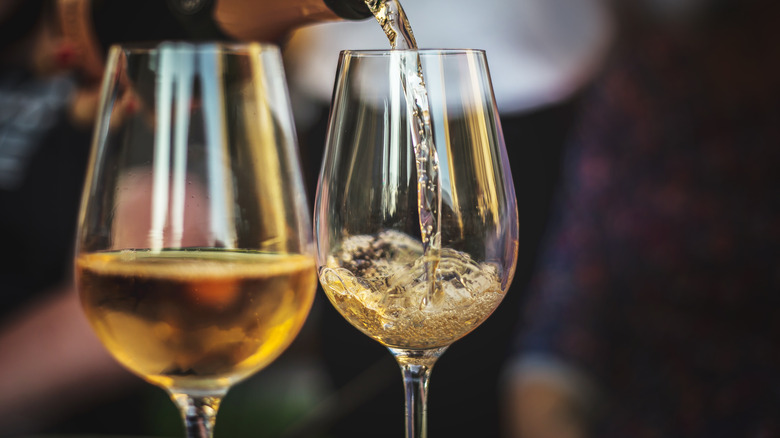This Is The Glass You Should Actually Be Drinking Champagne Out Of
There's nothing quite as synonymous with the idea of celebration than a sparkling flute of Champagne. The slender, tall-stemmed glasses certainly look elegant to begin with, but that's not the only reason flutes tend to be the glassware of choice when it comes to raising a toast. As it happens, their elongated, cylindrical shapes are specifically designed to accelerate and accentuate the dazzling swirls of bubbles, allowing for a fizzy display of effervescence as they rise to the rim. But, though those pearls of carbonation work to further inspire a sense of revelry, the flute's design is, unfortunately, more about style than substance. Sorry to burst your bubble, but that fancy flute isn't the best option for drinking Champagne or any other sparkling wine. Neither are the other popular glassware alternatives: the short, saucer-like coupe or the curvaceous tulip glass.
So, which kind of glass should you actually be pouring your bubbly into? Well, it turns out a regular ol' white wine glass is your best bet. Ask any Champagne connoisseur and they'll tell you that to truly appreciate the bouquet of a fine bubbly, you must engage your olfactory sense, which plays a major role in the perception of flavor. To sufficiently savor the aroma of your sip, the opening of your glass must be wide enough to let it waft out and reach your nostrils. The bowl, meanwhile, should be large enough to let your bubbly breathe.
For the best sip, the secret is in the shape
According to Champagne physicist Gérard Liger-Belair, the skinny flute has a rim that's much too thin to suitably disperse Champagne's all-important aromatic notes. The shallow coupe, meanwhile, dissipates the bubbles (which carry those powerful bursts of fragrance) too quickly, and the tulip glass's thinner opening also hinders the release of the scent. All three lack the wide, deep bowl needed to swirl and release the fragrance notes of your sparkling wine, Champagne or otherwise.
The manufacturers at Riedel, the famed glassware company, have long maintained that the profile of a beverage (including its taste and aroma) is affected by the shape and size of your glassware. Indeed, the wide, rounded bowl of a conventional wine glass allows for optimized effervescence, and gives your sparkling wine a chance to oxidize, which enhances its aroma and deepens its flavor.
The real secret of its success, however, lies in the wider diameter of its rim. As opposed to a narrow flute, a typical wine glass rim is large enough to present your palate and your nose with a full range of aromatics. Liger-Belair, along with the pros at Riedel, agree that a conventional wine glass is more suitable for truly appreciating a fine wine, even when it's bursting with bubbles. While the flute will always be a celebratory staple, you may want to leave it in the cupboard next time so you can truly savor your sip of Champagne.

